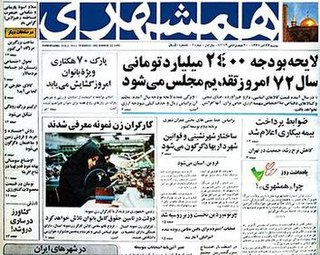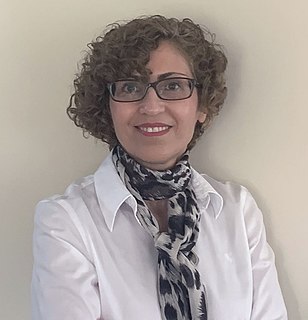The Media of Iran are privately and publicly owned but is subject to censorship. As of 2016, Iran had 178 newspapers, 83 magazines, 15,000 information sites and 2 million blogs. [1] A special court has authority to monitor the print media and may suspend publication or revoke the licenses of papers or journals that a jury finds guilty of publishing anti-religious material, slander, or information detrimental to the national interest. The Iranian media is prohibited from criticizing the Islamic doctrines (as interpreted by the Iranian government).[ citation needed ]
Most Iranian newspapers are published in Persian, but newspapers in English and other languages also exist. The most widely circulated periodicals are based in Tehran. Popular daily and weekly newspapers include Iran , Ettelaat , Kayhan , Hamshahri and Resalat . Iran Daily and Tehran Times are both English language papers. [2] Iran’s largest media corporation is the Islamic Republic of Iran Broadcasting (IRIB). [2] Financial Tribune is the main English language (online) economic journal. Iran Front Page ( IFP News ) is an English News website which provides its audiences with the English version of the latest news and views from Iran published by the Iranian Persian media. [3]
A number of foreign broadcasts into the country exist, including Persian language programmes from Kol Israel and Radio Farda; however, these broadcasts tend to encounter occasional radio jamming. [4] The government engages in censorship programs to anything divergent from the country's regulations. [5] [6] The majority of Iranians- upwards of 80 percent- get their news from government-owned media. [7] Attempts to establish private, independent media outlets in Iran have been restricted or banned, and Reporters Without Borders has declared Iran to have the highest number of jailed journalists in the Middle East. According to the 1979 Iranian Constitution, all broadcasting must exclusively be government-operated, and in 1994 the Islamic Republic banned the use of satellite television. [8] Yet, over 30 percent of Iranians watch satellite channels. [9]
Iranian media include:

The Islamic Republic of Iran Broadcasting (IRIB), formerly called National Iranian Radio and Television until the Iranian revolution of 1979, is an Iranian media corporation which holds a monopoly of domestic radio and television services in Iran, and is also among the largest media organizations in the Asian and Pacific regions, and a regular member of Asia-Pacific Broadcasting Union. IRIB is independent of the Iranian government, but its head is appointed directly by the Supreme Leader, Ayatollah Ali Khamenei.

The media of South Africa has a large mass media sector and is one of Africa's major media centres. While South Africa's many broadcasters and publications reflect the diversity of the population as a whole, the most commonly used language is English. However, all ten other official languages are represented to some extent or another. Afrikaans is the second most commonly used language, especially in the publishing sector.

Hamshahri is a major national Iranian Persian-language newspaper.

Radio Farda is the Iranian branch of the U.S. government-funded Radio Free Europe/Radio Liberty (RFE/RL) external broadcast service for providing the U.S. Government's perspective regarding news about Iran. It broadcasts 24 hours a day in the Persian language from its headquarters in the district Hagibor of Prague, Czech Republic.
In 2019, Reporters Without Borders ranked Iran 170 out of 180 countries in the World Press Freedom Index. This index lists countries from 1 to 180 based on the level of freedom journalists have to do their job. Reporters Without Borders described Iran as “one of the world's most repressive countries for journalists for the past 40 years”. In the Freedom House Index, Iran also scores low on political rights and civil liberties and is classified as “not free”.

Al-Alam is an Arabic news channel broadcasting from Iran and owned by the state-owned media corporation Islamic Republic of Iran Broadcasting (IRIB).

Radio Zamaneh is an Amsterdam-based Persian language radio. "Zamaneh" is the Persian literary term for "time".
Multiple forms of media including books, newspapers, magazines, films, television, and content published on the Internet are censored in Saudi Arabia.

Press TV is a 24-hour English- and French-language news and documentary network affiliated with Islamic Republic of Iran Broadcasting (IRIB). Press TV is headquartered in Tehran. The service is aimed at overseas markets.

In the first few years of the 21st century, Iran experienced a great surge in Internet usage. As of 2018, Iran has an estimate Internet penetration rate of between 64% to 69% out of a population of about 82 million.
Algeria has more than 45 independent Arabic language and French language publications as well as 4 government-owned newspapers, but the government controls most printing presses and advertising. The Algerian newspapers with the largest circulations are Echourouk (1,800,000), Ennahar (1,600,000), El Khabar (1,000,000) and Quotidien d'Oran (700,000); all four are employee-owned. The government also owns all radio and television outlets, which provide pro-government programming. In 2004 and 2005, the government increased the access of Berber language and culture to both print and broadcast media.
Jam-e Jam is a Persian language daily newspaper published in Iran.

BBC Persian Television is the BBC's Persian language news channel that was launched on 14 January 2009. The service is broadcast by satellite and is also available online. It is aimed at the 120 million Persian-speakers in Iran, Afghanistan, Tajikistan, and Uzbekistan.

HispanTV is an Iranian Spanish language news channel operated by IRIB, Iran's state-owned public broadcasting corporation. It began broadcasting in December 2011.
Public diplomacy in the Islamic Republic of Iran refers to the public relations efforts to disseminate information about the Islamic Republic of Iran. Such efforts seek to communicate with foreign publics in order to establish a dialogue designed to inform and influence. Instruments of public diplomacy in the Islamic Republic of Iran include cultural exchanges, film and print media, and sports diplomacy.
Television was first introduced to Iran in 1958, as a privately owned and commercially operated enterprise, before being nationalised, remaining a state-controlled monopoly, first of National Iranian Radio and Television, and following the Iranian Revolution in 1979, of Islamic Republic of Iran Broadcasting.
The Media of Qatar relays information and data in Qatar by means of television, radio, cinema, newspapers, magazines and the internet. Qatar has established itself as a leading regional figure in mass media over the past decade. Al Jazeera, a global news network which was established in 1996, has become the foundation of the media sector. The country uses media to brand itself and raise its international profile.

IRIB Ofogh, is an Islamic Republic of Iran Broadcasting television channel, is broadcast Worldwide.

Akram Pedramnia is an Iranian-Canadian writer, translator, Joycean scholar, researcher, activist, and physician. She has written, researched, and translated many English novels and political articles. She resides in Canada since 1998 when she had emigrated from Iran.
|journal= (help)This article's use of external links may not follow Wikipedia's policies or guidelines.(February 2020) (Learn how and when to remove this template message) |
Collaborative network designed to enhance the understanding of Iran's media ecology